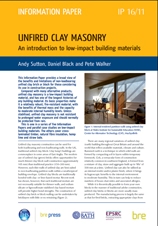Unfired clay masonry: An introduction to low-impact building materials
BRE (Building Research Establishment) is an independent, research-based consultancy, testing and training organisation, operating in the built environment and associated industries.
Unfired clay masonry: An introduction to low-impact building materials, was written by A Sutton, D Black and P Walker and published by BRE on 18 October 2011.
It is one of a series of five information papers and case studies about low-impact building materials, which also cover; hemp lime, straw bale, cross-laminated timber and natural fibre insulation.
In comparison with some alternative construction products, unfired clay masonry is relatively low-impact, and it has one of the longest histories of use of any building material. It is relatively robust, fire-resistant, has high thermal mass and has the capacity to moderate internal humidity levels. However, unless stabilised, it is not resistant to prolonged water exposure and so it normally requires protection from rain.
This 6-page information paper provides an overview of the pros and cons of non-loadbearing unfired clay brick and block. It is intended for those considering the use of this material on construction projects.
[edit] Related articles on Designing Buildings Wiki
- Adobe.
- Arup and Better Shelter at the Working Together For Disaster Relief conference.
- Blockwork.
- BRE articles on Designing Buildings Wiki.
- BRE Buzz articles on Designing Buildings Wiki.
- BRE Buzz.
- Brick.
- Building Research Establishment.
- Clay.
- Cob building.
- Cross-laminated timber.
- Defects in brickwork
- Defects in stonework.
- Earth building.
- Earthen construction.
- Green building.
- Hempcrete.
- Masonry.
- Parapet.
- Practical Building Conservation: Earth, Brick and Terracotta.
- Straw bale construction.
- Terracotta.
Featured articles and news
RTPI leader to become new CIOB Chief Executive Officer
Dr Victoria Hills MRTPI, FICE to take over after Caroline Gumble’s departure.
Social and affordable housing, a long term plan for delivery
The “Delivering a Decade of Renewal for Social and Affordable Housing” strategy sets out future path.
A change to adoptive architecture
Effects of global weather warming on architectural detailing, material choice and human interaction.
The proposed publicly owned and backed subsidiary of Homes England, to facilitate new homes.
How big is the problem and what can we do to mitigate the effects?
Overheating guidance and tools for building designers
A number of cool guides to help with the heat.
The UK's Modern Industrial Strategy: A 10 year plan
Previous consultation criticism, current key elements and general support with some persisting reservations.
Building Safety Regulator reforms
New roles, new staff and a new fast track service pave the way for a single construction regulator.
Architectural Technologist CPDs and Communications
CIAT CPD… and how you can do it!
Cooling centres and cool spaces
Managing extreme heat in cities by directing the public to places for heat stress relief and water sources.
Winter gardens: A brief history and warm variations
Extending the season with glass in different forms and terms.
Restoring Great Yarmouth's Winter Gardens
Transforming one of the least sustainable constructions imaginable.
Construction Skills Mission Board launch sector drive
Newly formed government and industry collaboration set strategy for recruiting an additional 100,000 construction workers a year.
New Architects Code comes into effect in September 2025
ARB Architects Code of Conduct and Practice available with ongoing consultation regarding guidance.
Welsh Skills Body (Medr) launches ambitious plan
The new skills body brings together funding and regulation of tertiary education and research for the devolved nation.
Paul Gandy FCIOB announced as next CIOB President
Former Tilbury Douglas CEO takes helm.
UK Infrastructure: A 10 Year Strategy. In brief with reactions
With the National Infrastructure and Service Transformation Authority (NISTA).
























